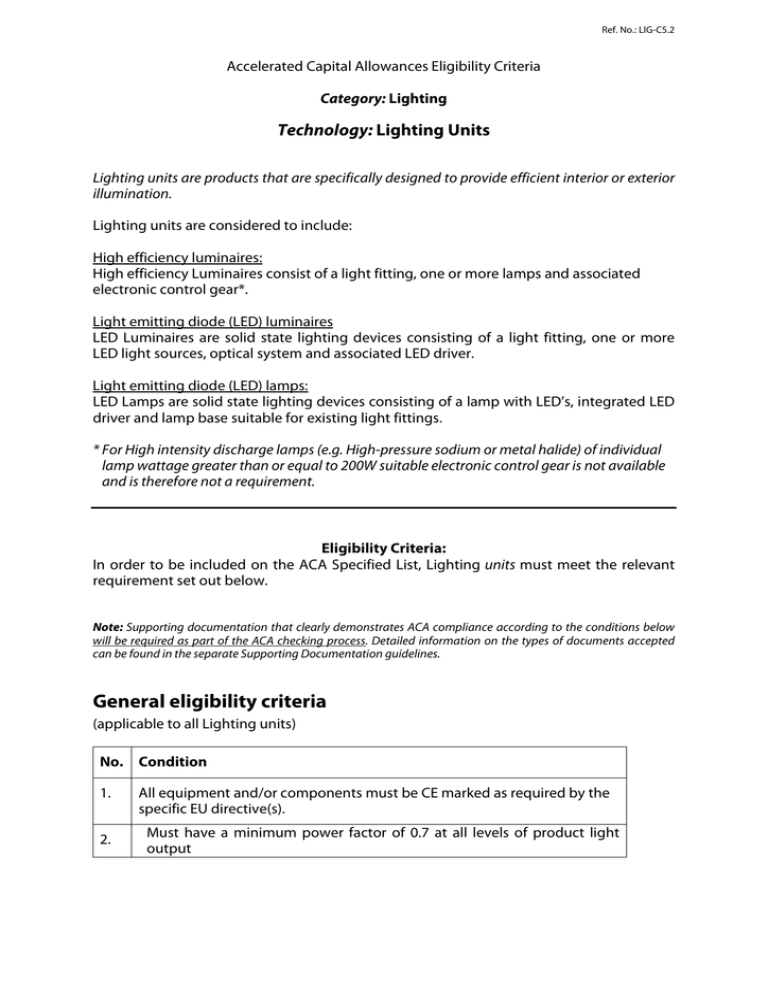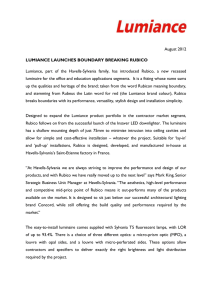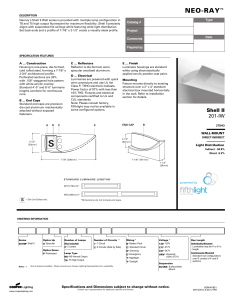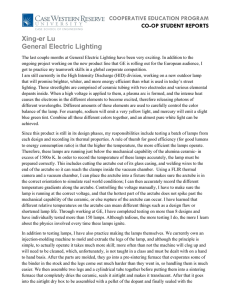Lighting Units
advertisement

Ref. No.: LIG-C5.2 Accelerated Capital Allowances Eligibility Criteria Category: Lighting Technology: Lighting Units Lighting units are products that are specifically designed to provide efficient interior or exterior illumination. Lighting units are considered to include: High efficiency luminaires: High efficiency Luminaires consist of a light fitting, one or more lamps and associated electronic control gear*. Light emitting diode (LED) luminaires LED Luminaires are solid state lighting devices consisting of a light fitting, one or more LED light sources, optical system and associated LED driver. Light emitting diode (LED) lamps: LED Lamps are solid state lighting devices consisting of a lamp with LED’s, integrated LED driver and lamp base suitable for existing light fittings. * For High intensity discharge lamps (e.g. High-pressure sodium or metal halide) of individual lamp wattage greater than or equal to 200W suitable electronic control gear is not available and is therefore not a requirement. Eligibility Criteria: In order to be included on the ACA Specified List, Lighting units must meet the relevant requirement set out below. Note: Supporting documentation that clearly demonstrates ACA compliance according to the conditions below will be required as part of the ACA checking process. Detailed information on the types of documents accepted can be found in the separate Supporting Documentation guidelines. General eligibility criteria (applicable to all Lighting units) No. Condition 1. 2. All equipment and/or components must be CE marked as required by the specific EU directive(s). Must have a minimum power factor of 0.7 at all levels of product light output Ref. No.: LIG-C5.2 High Efficiency Luminaires – specific eligibility criteria (to be met in addition to the general eligibility criteria) No. Condition 3. The photometric data of the Luminaires must have been measured and tested in accordance with EN 13032-1&2 “Light and lighting – Measurement and presentation of photometric data of lamps and Luminaires” 4. Must meet the minimum efficacy criteria required for high efficiency luminaires as outlined in Table 1 All lamps and control gear must be ENEC marked or comply with the relevant performance standards. 5. LED lamps and luminaires – specific eligibility criteria (to be met in addition to the general eligibility criteria) No. 6. Condition The photometric data of the Luminaire or lamp must have been measured and tested in accordance with: EN 13032-1&2 “Light and lighting – Measurement and presentation of photometric data of lamps and Luminaires” or IES LM-79-08 “Electrical and photometric measurements of SolidState lighting products”. 7. Must have a light output (in lumens) not less than 90% of initial1 light output after 6,000 hours of continuous operation and which is tested according to: IEC/PAS 62612 “Self ballasted LED-Lamps for general lighting services – performance requirements” or IES LM-80-08 “Measuring Lumen maintenance of LED light sources”. 1 8. Luminaires must meet the minimum efficacy criteria required for LED luminaires as outlined in Table 1. Lamps must meet the minimum efficacy criteria in table 2. 9. A minimum lumen output of 150 lumens for the whole lamp or luminaire. Initial lumens measured after 100 hours operation. Ref. No.: LIG-C5.2 10. 11. A colour rendering index not less than Ra70. A rated Correlated Colour Temperature between 2500 and 6500K Table 1 – Luminaires: Minimum efficacies table for high-efficiency and LED Luminaires Luminare type Minimum efficacy (l l/cW) High-pressure sodium ≥200W per lamp 80 High-pressure sodium <200W per lamp 65 Metal halide Linear Fluorescent* 65 55 Compact Fluorescent* ≥ 300mm** 55 Compact Fluorescent* < 300mm** 45 Induction 45 LED 45 *Linear and Compact Fluorescent luminaires must have High frequency control gear incorporated into the fitting ** 300mm in longest dimension ll/cW = Luminaire Lumens per circuit Watts = Total Lumen Output x Light Output Ratio Circuit Power Drawn Where: Total lumen output (Lumens)= the total light output of all the lamps in the fitting (measured in Lumens), 2 Light Output Ratio (LOR) = ULOR and DLOR values may be combined where the fitting is designed to provide direct and indirect lighting, otherwise only the LOR in the intended lighting direction may be used. Circuit Power Drawn (Watts) = the electrical power drawn by the whole luminaire from main circuit connection point to lamp, including losses in the control gear (ballast)2 Some fluorescent lamps are labelled and branded with the wattage (power) consumed when operated on standard 50Hz (i.e. not high-frequency) control gear. When operated on high-frequency control gear the watts consumed are less. Ref. No.: LIG-C5.2 Table 2 – Lamps: Minimum efficacies table for LED lamps LED Lamptype Minimum efficacy l/cW Omni-directional* 45 Directional* 45 *As defined under Energy Star. l/cW = Lumens per circuit Watts = total lumen output circuit power drawn Where: Total lumen output (Lumens)= the total light output of the lamp Circuit Power Drawn (Watts) = the electrical power drawn by the whole lamp, including losses in the LED driver. ---------------------------------- End of ACA eligibility criteria -------------------------------Please see next section for guidance on: 1. Technical details required in product submission 2. Supporting documentation required Ref. No.: LIG-C5.1 Guidance on product details and supporting documentation NOTE: The following information is not part of the official criteria document published within the relevant Statutory Instrument. It has been added here for guidance purposes only in order to help you to provide (a) product details and (b) the required supporting documentation. All information contained in this guidance document is subject to change without notice. Technical information required in product submission The following are the specific technical values required as part of the product submission for this technology: Lighting unit type As part of the product submission you must first select which type of lighting product your product is. Only one type can be chosen per product. Rated lamp lifetime For all lighting types the rated lamp lifetime in hours must be submitted to here. It must be entered as number only (do not include units). There should also be no spaces or full stops after the number submitted. Fitting Light Output Ratio (LOR) For all lighting types except LED lamps the LOR must be submitted here. It must be entered as a whole number only, e.g. 75% is entered as 75 and not as 0.75 or 75%. There should also be no spaces or full stops after the number submitted. Lighting Unit Power Rating For all lighting types the total circuit power consumption in Watts must be submitted here. This is for the actual power consumed by the complete lighting unit and includes the Ballast or Driver power consumption. It must be entered as a number only (do not include units). There should also be no spaces or full stops after the number submitted. Total Lumens output For all lighting types the total lumens output must be submitted here. This is the lumen output for the replacement LED lamp or all the lamps in the lighting unit, or for the full fitting in the case of LED luminaires. It must be entered as a number only (do not include units). There should also be no spaces or full stops after the number submitted. Note that in the case of LED’s the lumens output figure is that measured after 100 hours of continuous operation. Lighting unit efficacy ([L]L/CW) For all lighting units the efficacy must be submitted here. For luminaires this figure is a multiple of the total lamp lumens and the Light Output Ratio in the intended direction divided by the total circuit watts consumed by the lamps and control gear. The definition is Luminaire Lumens per Circuit Watts (LL/CW). Page 5 of 15 Ref. No.: LIG-C5.1 For LED replacement lamps the value is the measured lumen output of the whole lamp divided by the total circuit watts consumed by the lamp and control gear (driver). The definition is Lamp Lumens per Circuit Watts (L/CW) The efficacy is automatically calculated during the submission process and only products which meet the minimum criteria levels will be successfully submitted. Supporting documentation required Described below is the list of documents that are accepted as proof of compliance for the specific Lighting conditions. Note: This information will only be requested AFTER you submit your product’s basic details online Important Notes to Product Providers Please ensure that you read the “Important Notes to Product Providers” section at the end of this document prior to submitting documentation. Page 6 of 15 Ref. No.: LIG-C5.1 General eligibility criteria No. 1 Condition Supporting Documentation Requirement All equipment and/or components must be CE marked as required by the specific EU directive(s). Official and published manufacturer’s technical data sheet or brochure that demonstrates CE marking compliance OR A copy of an official signed declaration on headed paper that confirms CE marking compliance. Official declarations should explicitly state the product for which CE marking is being confirmed (i.e. do not provide a letter simply stating general compliance with the relevant ACA condition). Where a document is used to demonstrate conformance for a number of products or range of products, it should clearly specify each individual product covered by that document. 2. Must have a minimum power factor of 0.7 at all levels of product light output Official and published manufacturer’s technical data sheet or brochure that demonstrates compliance with the requirements of the condition. Note: For LED products this document should show that the power factor of the unit was measured in accordance with EN62384. High Efficiency Luminaires – specific eligibility criteria No. 3. Condition Supporting Documentation Requirement The photometric data of the Luminaires must have been measured and tested in accordance with EN 13032-1&2 “Light and lighting – Measurement and presentation of photometric data of lamps and Luminaires” Supporting Documentation Requirements Accredited certification that the equipment has been tested according to the named standard. OR Evidence of official testing by manufacturer or independent test lab carried out according to the principles outlined in the named standard. Test reports should be of the format described in the ‘Important notes to Product Providers’ section of this document. All evidence that is supplied MUST refer to the entire lighting unit (i.e. fitting, control gear and lamp). See note on ‘Scientific Equivalence’ in Important Notes to Product Providers section at end of this document. Page 7 of 15 Ref. No.: LIG-C5.1 No. 4. Condition Supporting Documentation Requirement Must meet the minimum efficacy criteria Evidence of official photometric testing by manufacturer or independent test lab carried out according to the required for high efficiency luminaires as principles outlined in the named standard in condition 3. The calculation MUST refer to the entire lighting unit outlined in Table 1 (i.e. Fitting, Control Gear and Lamp), and not individual components. The evidence supplied should detail the LL/cW calculation, clearly showing the method by which the efficacy figure (as measured in Luminaire Lumens per circuit Watts) was achieved and detailing where the figures used during the calculation (lamp lumens, LOR, power consumption) can be referenced in the photometric report. Note: For all fluorescent fittings, and those using high-intensity discharge lamps of less than 200W (per individual lamp), evidence of the use of electronic control gear must be provided. For compact fluorescent lamps documentation showing the longest dimension of the lamp must be submitted. The LL/CW calculation multiplies the total output of the lamps (Lumens) and the efficiency of the fitting in redirecting the light (Light Output Ratio, LOR) and divides by the power drawn by lamps and all the associated control gear (measured in Watts). The output figure is Luminaire Lumens per circuit Watts (LL/cW). 5. All lamps and control gear must be ENEC For Control Gear with ENEC marking only: marked or comply with the relevant Official and published manufacturer’s technical data sheet or brochure that demonstrates ENEC marking performance standards. compliance OR A copy of an official signed declaration on headed paper that confirms ENEC marking compliance. For all Lamps and Control Gear without ENEC marking: Official and published manufacturer’s technical data sheet or brochure that demonstrates compliance to the relevant performance standard(s) and an official signed declaration on headed paper confirming that the luminaire is only supplied with lamps that comply with the relevant performance standards OR Continued overleaf........... Page 8 of 15 Ref. No.: LIG-C5.1 No. Condition Supporting Documentation Requirement An official signed declaration on headed paper confirming compliance with the relevant performance standard(s) and confirming that the luminaire is only supplied with lamps that comply with the relevant performance standards Note: Where a datasheet or brochure is used to demonstrate conformance for a number of products or range of products, it should clearly specify each individual product covered by that document. Official declarations should explicitly state the product for which the performance standard(s) or ENEC marking are being confirmed. Relevant standards must also be clearly listed. (i.e. do not provide a letter simply stating general compliance with the relevant ACA condition). Relevant performance standards are: Fluorescent control gear: I.S. EN 61347-1; I.S. EN61347-2-3; I.S. EN60929; I.S. EN61547; I.S. EN62386 Parts 101, 102 and 201 (for Digital Addressable control gear only) Discharge control gear: I.S. EN61347-1; I.S. EN61347-2-9 (magnetic); I.S. EN61347-2-12 (electronic); I.S. EN61547 Fluorescent lamps: I.S. EN 60901 (single capped); I.S. EN60081 (double capped) Discharge lamps: I.S. EN60192 (LPS); I.S. EN60662 (HPS); I.S. EN61167 (MH) Page 9 of 15 Ref. No.: LIG-C5.1 LED lamps and luminaires – specific eligibility criteria No. 6. Condition Supporting Documentation Requirement The photometric data of the Luminaire or Supporting Documentation Requirements lamp must have been measured and Accredited certification that the equipment has been tested according to one of the named standards. tested in accordance with: EN 13032-1&2 “Light and lighting – Measurement and presentation of photometric data of lamps and Luminaires” or IES LM-79-08 “Electrical and photometric measurements of Solid-State lighting products”. OR Evidence of official testing by manufacturer or independent test lab carried out according to the principles outlined in one the named standards. Test reports should be of the format described in the ‘Important notes to Product Providers’ section of this document. All evidence that is supplied MUST refer to the entire lighting unit (i.e. fitting, control gear and lamp, where relevant). See note on ‘Scientific Equivalence’ in Important Notes to Product Providers section at end of this document. Page 10 of 15 Ref. No.: LIG-C5.1 No. 7. Condition Supporting Documentation Requirement Must have a light output (in lumens) not The supporting documentation required to demonstrate the lifetime of LED luminaires and LED lamps is less than 90% of initial* light output after detailed below. Please note that some requirements differ between the two LED types. 6,000 hours of continuous operation and which is tested according to: For both LED types all photometric data recorded during the specific lifetime test must be based on the principles of EN 13032 or LM 79-08 as per condition 6. IEC/PAS 62612 “Self ballasted LED-Lamps for general lighting services – performance requirements” LED luminares: or Evidence of official lifetime (Lumens maintenance) testing by manufacturer or independent test lab carried out IES LM-80-08 “Measuring Lumen according to the principles outlined in one the named standards. maintenance of LED light sources”. When following the Energy Star LM-80-08 testing standard, LED luminaire lumens maintenance testing can be of two forms, either component performance or complete luminaire performance: 1. The Component Performance option allows one to demonstrate compliance with the lumen * Initial lumens is measured after 100 hours maintenance requirement by demonstrating that a LED package, module or array tested to LM-80-08 operation. operates at or below specified temperatures when operated in situ. For this the following data must be supplied: LM-80-08 test report showing that the LED package, module or array has 90% lumens maintenance after 6000h LM-80-08 complaint test report showing that the complete luminaire with the tested LED package, module or array built in maintains the same specified temperature as applied during the LED package, module or array lifetime test. Full details on the accepted component performance methodology can be found on the Energy Star website, http://www.energystar.gov/index.cfm?c=ssl_res.pt_ssl 2. The Luminaire performance test demonstrates compliance with the lumen maintenance requirement by submitting an LM-80 or IEC/PAS 62122 test report for the entire luminaire. LED Lamps Evidence of official lifetime (Lumens maintenance) testing by manufacturer or independent test lab carried out according to the principles outlined in one the named standards. Page 11 of 15 Ref. No.: LIG-C5.1 No. 8. Condition Luminaires must meet the minimum efficacy criteria required for LED luminaires as outlined in Table 1. Lamps must meet the minimum efficacy criteria in table 2. Supporting Documentation Requirement The lamp or luminaire lumens per circuit watt value is not necessarily the LED manufacturer’s lumens per watt value, it is the final efficacy of the complete lamp or luminaire. A complete lamp or luminaire is considered to include the LED light source, integrated or associated driver, optics (and for lamps, a suitable socket in which it is operated). To demonstrate compliance with this requirement, independent or accredited manufacturers photometric testing of the complete lamp or luminaire must be provided. All photometric data recorded must be based on the principles of EN 13032 or LM 79-08 as per condition 6. For LED Luminaires The LL/CW calculation multiplies the total output of the lamps (Lumens) and the efficiency of the fitting in redirecting the light (Light Output Ratio, LOR) and divides by the power drawn by lamps and all the associated control gear (measured in Watts). The output figure is Luminaire Lumens per circuit Watts (LL/cW). For LED Lamps: The LL/CW calculation divides the total output of the lamp (Lumens) by the power drawn by lamp and all the associated control gear (measured in Watts). I.e. LED lamps undergo absolute photometric performance testing which does not include measurement of LOR. The output figure is Lumens per circuit Watts (L/cW). Note: All measurements must be taken after the junction temperature has stabilised to a constant level. 9. A minimum lumen output of 150 lumens The lamp or luminaire lumens per circuit watt value is not necessarily the LED manufacturer’s lumens per watt for the whole lamp or luminaire. value, it is the final efficacy of the complete lamp or luminaire. A complete lamp or luminaire is considered to include the LED light source, integrated or associated driver, optics (and for lamps, a suitable socket in which it is operated). To demonstrate compliance with this requirement, independent or accredited manufacturers photometric testing of the complete lamp or luminaire must be provided. All photometric data recorded must be based on the principles of EN 13032 or LM 79-08 as per condition 6. Page 12 of 15 Ref. No.: LIG-C5.1 No. Condition Supporting Documentation Requirement 10. A colour rendering index not less than Official and published manufacturer’s technical data sheet , brochure or test report that demonstrates Ra70. compliance with this requirement. 11. A rated Correlated Colour Temperature Official and published manufacturer’s technical data sheet , brochure or test report that demonstrates between 2500 and 6500K compliance with this requirement. Page 13 of 15 Ref. No.: LIG-C5.1 Important Notes to Product Providers General There should be a clear link between all supporting documentation supplied and the product being submitted. This will typically take the form of a product code or product name that can be cross referenced between the submitted product and relevant supporting documentation. If product codes / names have been changed since publication of the supporting documentation, then official evidence of this must be provided with the supporting documentation supplied. Any deviation from these requirements will result in the supporting documentation not being considered adequate for the purposes of demonstrating compliance with the criteria conditions. This will in turn delay the submission and/or result in the product not being considered eligible. Where the ACA criteria or help documentation reference compliance to appropriate rather than specific standards, the onus is on the product provider to ensure that supporting documentation supplied references recognised standards that apply to the submitted product, i.e. the product must be covered under the scope of a recognised standard. If any product submitted is later found not to meet the performance or specification criteria, then this product will cease to be considered eligible for the ACA. Note: When supplying the supporting documentation through the online process you must ensure that the correct page number(s) of the document is referenced when compliance with the relevant condition is being demonstrated. An explanatory note should also be given where more than one page number is referenced. Test Report A test report must comprise of the following elements: An outline of the complete test including introduction, details on test conditions, the specific model details of the product tested, the steps taken in the test, the results, graphical representations, and a conclusion. All documents should be on headed paper and the document should be officially signed off. All documentation must be in English, or include adequate translation. Certification Where certificates are provided, all tests must be carried out by an organisation that is accredited by a national accreditation body recognised via the European Cooperation for Accreditation (preferred) or the International Accreditation Forum. All documentation must be in English, or include adequate translation. Scientific Equivalence Some ACA criteria conditions allow for scientifically equivalent tests and/or standards to be used. In the event that a product has not been designed, manufactured or tested to the specific standard named, then documentation relating to an equivalent internationally recognised standard may be used (where the phrase ‘Or scientific equivalent’ is included in the ACA condition or help documentation). In such applications, the onus will be on the product submitter to demonstrate satisfactory equivalence of the standards. However, submissions which reference such supporting documentation may take longer to process, and if the product provider does not provide satisfactory evidence of equivalence, then the product will not be considered eligible for the ACA. All documentation must be in English, or include adequate translation. Page 14 of 15 Ref. No.: LIG-C5.1 Note: Where specific standards are cited in a condition or in the ACA help documentation, then documentation demonstrating that the relevant products have been designed, manufactured or tested to these specific standards is preferred. Scientific equivalence is considered the exception rather than the norm. Representative testing Where test information is required for a range of technically similar products (e.g. configurations of one base product) then in exceptional instances a form of representative testing may be utilised once agreed in advance with SEI. Such testing is where only representative products are tested from a technically similar group or range of products. Provided a clear correlation can be demonstrated between the tested product and technically similar non-tested product, and that such a correlation clearly demonstrates the compliance of the non-tested product, representative testing may form an acceptable basis for supporting documentation. Note: Where representative testing is used for a group or range of products, if the tested or representative product is removed from the list of eligible products then all related products are also removed. Page 15 of 15





